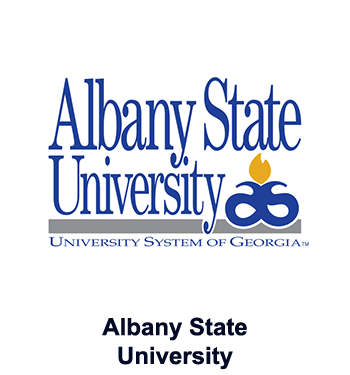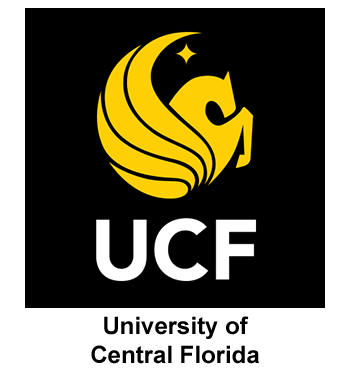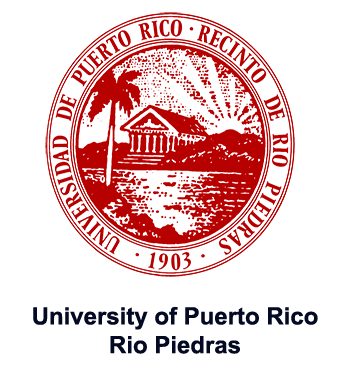Please feel free to interact with the map below by clicking on the
individual College / University pins, zooming in (Plus Sign) and zooming out (Minus Sign.)
individual College / University pins, zooming in (Plus Sign) and zooming out (Minus Sign.)

Alabama A&M University - Ctrl Intelligence
The goal of team Ctrl Intelligence believes that we have the innovation to make space exploration happen. One of the limitations of exploration is autonomous traversal. Due to the issue of energy preservation as well as live data collection from independently controlled autonomous vehicles, traversal of Robotic AI becomes a challenge. An intelligent system of self-sufficient path-generating drones makes exploration of the lunar surface much safer, faster, and much more efficient. Ctrl Intelligence plans to program and integrate advanced collision avoidance algorithms with the goal of image analysis and data analytics to provide topographic data collection of other planetary bodies.

Albany State University - NASA ROVER AI-EYES
This research extends the work done last year. The study presents the development and implementation of deep learning algorithms for automatic detection, classification and cataloging of craters on the planet Mars using Tensor flow. Crater detection and identification are widely used and are key technologies in deep space exploration. Many scientific applications require these methods. By measuring the radius, circumference, depth, latitude, and longitude of the crater, rovers can safely navigating through dangerous terrain on Mars. The rover will know where craters are and avoid them. Secondly, the rover will detect new craters and catalog them when navigating new territory.

Bowie State University - Space Bulldogs
The recent popularity of machine learning (ML) algorithms has expanded to numerous scientific and real- world applications. However, the large datasets required by such algorithms can create large computational overhead and reduce the overall performance. In this project, we seek to address this problem by evaluating the performance of ML using new computing technologies. The goal of the project is to better understand the ideal computing environment and technology that will maximize the accuracy and speed of ML algorithms. This project will support NASA’s Artemis mission by strengthening experiments and technologies that use ML algorithms.

Bunker Hill Community College - The Gaia Initiative
The aim of the Gaia Initiative is the automation and data collection of the Moringa Oleifera plant to make progress in the field of sustainable food resource systems. This plant is visually expressive in nature, we will use image recognition software and sensors to maximize our automation system. Collecting such data during the Artemis mission would pave the way for advancing food resources that will define the future of space travel. With both an Engineering and Environmental team, our goal is to achieve a fresh, sustainable, resilient, and nutritious food source as we explore the cosmos.

California State Polytechnic University Pomona - Kepler-1708b
Nowadays, electric cars, combined with the technology of unmanned vehicles, are used to help society get better services. The Kepler-1708 b team plans to build a mechanical prototype that combines drones and Unmanned ground vehicles (UGVs) in one structure. The proposed robot is unique in terms of suitability for exploring rough terrain areas such as the moon's far side. The project aims to deliver an autonomous flying UGV that has the ability to perform tasks on the moon's rough surface from capturing high-end videos to delivering payloads, which is aligned with the ARTEMIS program and the deep space exploration needs.

California State Polytechnic University Pomona - Gliese-514b
The Gliese-514b team is planning to deliver a reconfigurable lightweight cryptographic processor which runs under physical and power restrictions. The proposed processor will be able to run different types of encryption/decryption schemes and apply hash functions to prove the data's integrity. For prototyping, the team will build a prototype of a tiny generation of drones that will be secured using the proposed processor. Gliese-514b processor will provide a security shield for the CubeSats, which the ARTEMIS will use to stream data from the Moon to the earth. Gliese-514b is a part of the reconfigurable space computing laboratory at CalPoly, Pomona.

California State Polytechnic University Pomona - TOI-1231b
This project focuses on developing a new mechanism that allows drones to exchange energy and data efficiently in mid-air. There are several innovations this project aims to deliver from building a new generation of drones that consumes less power than the existing solutions while it operates without blades. Moreover, the team seeks to construct an edge computing cluster from several drones using a Kubernetes container to manage the data workload balancing between the involved drones. The technology this project is creating will support the space exploration efforts led by the ARTEMIS program and exoplanet explorations in deep space.

California State Polytechnic University Pomona - Kepler-452b
Once quantum computers exist, there is a risk of creating chaos by losing all the services, which depends on the current security primitives we are dealing with in securing the data communications such as nuclear power plants, satellite communications, etc. As NIST announced, the need to have a set of cryptographic primitives to resist the existence of the Shor algorithm, which can break the conventional crypto primitives. The team is planning to deliver a new dynamic reconfigurable processor to secure space devices against quantum attacks, which can be used to support the ARTEMIS program activities.

California State University Fresno - The Bulldog Interface
The goal of this project is to improve a fully immersive virtual reality (VR) keyboard and investigate novel input modalities to facilitate multitasking (mouth switch, brain-computer interface). VR allows to minimize the weight and the number of instruments that are onboard in a spacecraft during the NASA's Artemis mission. Deep space transportation systems require enhanced user interfaces taking advantage of VR for offering large panels with quick direct access to commands, within a limited amount of space and weight. The project follows last year project by adding new input modalities and by assessing the performance with human participants.

California State University Los Angeles - Cryo-SpyderBot Team
The Cal State LA Cryo-SpyderBot Team will conduct ground-based research to develop a new class of robotic rovers capable of swarming maneuvers in Lunar Permanently Shaded Regions (PSRs). The Cryo-SpyderBots will be developed as a robotic swarm technology platform to support In-Situ Resource Utilization (ISRU). The Cal State LA Cryo-SpyderBots Team concept supports the NASA Artemis Mission objective of returning astronauts to the moon and the establishment of a sustainable presence, i.e., a Lunar Base Station. The Cryo-Swarm Team will design a lunar science mission to deliver of a cryogenically rugged Hexapod Lander, i.e., a Cryo- SpyderBot, to Lunar PSRs.

California State University Los Angeles - Cryo-Swarm Team
The Cal State LA Cryo-Swarm UAV team will conduct ground-based research to develop a new class of unmanned aerial vehicles (UAVs) for operation in Lunar Permanently Shaded Regions (PSRs). The Cryo-Swarm UAVs will employ machine learning swarming algorithms, such that these Cryo-Swarm UAV swarms could conduct lunar surface operations to enable In-Situ Resource Utilization (ISRU), specifically through exploration and documentation of locations of lunar water-ice. Through this, the Cal State LA Cryo-Swarm UAV team concept supports the NASA Artemis Mission objective of returning astronauts to the moon and the establishment of a sustainable presence, i.e., a Lunar Base Station.

Central Carolina Technical College - Titans of Networking
In this project, we present an innovative design idea for development of a wireless sensor network around the Lunar South Pole. We are focused on the construction of a lightweight, relocatable, inexpensive network control apparatus that will serve as a wireless network node. This node will continuously monitor its environment with various sensors, managing their data uploads as required. Additionally, the node will become a wireless access point and a signal extender for the resulting wireless network. The project goal is to design the control apparatus and associated computational capabilities. A, scaled down, prototype will demonstrate one such control node.

Clayton State University - Lakersbots
This project is to allow a swarm of cooperative robots to reason about uncertainty in the adversary lunar environment in order to make the best informed decisions. We accomplish this by equipping each robot with the multi-agent uncertain reasoning capability that allows the swarm to collaboratively derive the best interpretation of the system based on their prior knowledge and observations. The multi-agent uncertain inference method is fault-tolerant and works under uncertainty and communication limitations.

Fayetteville State University - Bronco Blue Bots
When Tesla sent the Roadster to space it was a symbolic gesture about our next steps into a bold new future. Similar advancements in swarm robotics will be necessary for the future navigation of extraterrestrial bodies. The Bronco Blue Bots goal is to achieve a similar leap of current navigation techniques while utilizing modern technologies. A swarm of robots will be fitted with a fusion of stereoscopic cameras and LIDAR. These technologies will work together to better navigate a capricious and extraterrestrial body, clearing the way of danger, and paving the path for a bold new future.

Georgia Gwinnett College - Team Grizzly
NASA astronauts may encounter hurdles and uncertainties during their journey and life on the moon. The proposed system will assist the Artemis mission by offering vital information on the surrounding area, to promote a safe environment during the voyage to and while residing on the lunar surface. Structural Analysis Using Contactless Evaluation 3.0 (S.A.U.C.E.-3.0) is a multifunctional, contactless device designed to evaluate structural integrity and changes in atmospheric conditions using environmental sensors. S.A.U.C.E.-3.0 stores data into a central location for analysis and review. This system is a continuation of S.A.U.C.E.-2.0, focusing on functionality, data storage, and compatibility with robotic systems.

Hillsborough Community College - HCC Engineering Society
The goal of our project is to build an autonomous robot that is able to mine and collect the ice water hidden inside the craters near the south pole of the moon, then return it back to its base. The craters are in the Permanently Shaded Regions (PSR) of the moon, meaning that there is no sunlight and no satellite communication going to the region. Our robot will be collecting lunar soil dense with the ice water that will be sustaining the astronauts of the Artemis Mission. This design will be the catalyst for bringing life to the moon.

Inter American University of Puerto Rico Bayamon Campus - Inter Space
Space travel requires that payloads are limited in both size and weight. This restricts the number of materials that can be sent outside earth’s atmosphere to create habitable modules. In future missions, crew members in the base camp will be exposed to cosmic radiation and meteorites. Our team proposes to develop a Lunar 3d printer to construct structures that can help shield astronauts from radiation. The design is based on an ordinary 3d printer. Our objective is to design and build a 3d printer capable of producing concrete structures using a lunar soil mix.

Inter American University of Puerto Rico Bayamon Campus - INTER TEAM
Dysfunction on the human auditory system in space missions had been commonly associated to long term exposure to a constant noise for the duration of a mission, an average 33% of astronauts experience permanent or temporary hearing disorder. To reduce the risk of hearing loss without uncomfortable hearing equipment for the astronauts, our team will develop a tool that will potentially cancel the unwanted background noise that they are subjected to, by applying active noise control to the system.

Mclennan Community College - Pleiades
Team Pleiades is composed of engineering students, each with an individual yearning to further our knowledge about human life on distant planets. In the previous year, we designed Atlas, whose objective was to provide NASA with an anchoring device that would be used by our astronauts to attach themselves and equipment to the lunar surface. After a year of new ideas, trials, and data, our wish is to take our original design and push our capabilities and skills. This will be accomplished by redesigning Atlas, providing NASA an optimized anchoring device to aid in our future lunar exploration.

Metropolitan State University Denver - MSU IEEE Robotics Club
MSU Denver’s Robotics Club is demonstrating the feasibility and efficiency of different cooperative information gathering strategies via swarm robotic simulations and demonstrations. Through this project we will be able to address the technological gap between robotic swarm control methods and autonomous mapping techniques by designing and deploying a robotic swarm control protocol for the purposes of autonomous surveying on the moon. This project aims to support the Artemis mission by expanding on cooperative information gathering research to inspect and map a target for resources and materials both above and below the surface area.

Miami Dade College - The Sharkponics
Our team is trying to solve the problem of sustainable nutrition on other planets by using an aquaponics system. These systems have already shown promise on Earth where they've been used to grow various nutritious plants using an aquarium as fertilizer. We are designing a system with specifically chosen plant and fish combinations to efficiently solve specific nutritional issues astronauts face. By the end of our experiment we aim to create a system that can supplement an astronaut's calcium and sodium intake using aquaponics.

Montgomery College - MC UV
Water-filtration technology has seen exponential improvement giving MCUV the opportunity to improve NASA’s filtration technology. MCUV intends to create a UV-C water purification system inside NASA’s current water tanks to irradiate harmful microbes and cleanse drinking water. The goal of this project is to reach a Bacteria count less than 50 CFU/mL, Microbial control against 100 targeted microbes, and a Coliform/Fungal/Parasitic Protozoa count of 0 per 100 mL in the tested water samples. This is crucial as astronauts must have access to clean water to maintain their health and well-being during the Artemis Space Mission.

New Mexico Institute of Mining & Technology - NMT Cave Divers
The NMT Cave Divers project aims to provide support and assistance to rovers in the evolving exploration of the lunar surface. The proposed technology consists of a grappling system that will be attachable to smaller lunar rovers for assistance in traversing the challenging underground terrain. Moreover, this design will assist rovers with the attached grappling hook to move along the lunar surface within craters and other difficult terrains. This project aims to provide a prototype grappling mechanism capable of being mounted onto various-sized rovers to provide terrain manipulation assistance.

New Mexico Institute of Mining & Technology - NMT Rolling Miners II
The purpose of this project is to design an autonomous swarm of biologically inspired robots that will propel research forward on the Moon during the Artemis mission. Like the pillbug, the Fengaribots have a protective exterior shell that can roll and unroll to traverse difficult terrain. Additionally, the robots will contain a dispersion mechanism to launch dandelion-inspired sensors which can improve observation of the environment. The unique properties of the Fengaribots allow them to navigate, map and detect areas of interest on the Moon.

Philander Smith College - Panthers
The process of locating items used by the ISS is time-consuming. Additionally, tags have a receiver component only and don't communicate with one another, which lowers the accuracy. The Panthers team will make finding objects in NASA's database efficient. The design intends to incorporate a receiver and emitter into each tag, enabling proper communication and quickly pinpoint the location of items. The proposed system will prevent unauthorized access and secure item tracking process. The Panthers team's goal is improve the inventory tracking system for NASA by increasing the accuracy of item detection, reducing the searching time, and secure the environment.

Santa Monica College - HiveMINDS
We want to create a robotic swarm system based on the behavior of bee colonies, for the mineralogical characterization of known areas of interest on the moon. We want our model to be completely autonomous until task completion, that is, until all known areas of interest have been characterized with the certainty that comes from ground-based sample collection and physical analysis. Our idea is for a swarm that maintains itself, repairs itself, directs itself, manages itself, moves itself, and even powers itself until its work is complete.

Seminole State College - Raider Engineering
The projected human presence and exploration on the lunar surface calls for auxiliary devices to handle tasks such as detailed aerial photography. Raider Engineering’s goal is to develop a drone that can be utilized for detailed photography of the lunar surface for the Artemis mission. To do so, our team will use existing drones as a base for the design, and will replace the propellers with compressed gas thrusters. This simple modification allows for flight over the lunar surface just like a drone on Earth. This will allow astronauts to do aerial photography easily and rapidly, allowing greater exploration opportunities.

Sonoma State University - Seawolf
In 2021, Ingenuity became the first aircraft to operate on Mars to support Perseverance’s ground exploration. A large portion of its battery capacity is reserved to keep equipment within operating temperature. Although equipped with a solar panel, the helicopter is not able to recharge from the rover. Hence, it has to take off at a specific time frame in the day to avoid losing reserve battery. This significantly reduces the flight durations. To solve this limitation, we will research an effective way to wirelessly transfer the power between a rover and an aerial vehicle to extend its task duration.

St. Thomas University - Omnitrix
Technology already exists that allows physicians to monitor biomarkers important in diagnostics; however, most tests require a blood sample, long wait times for results, lab testing, and educated personnel to explain the results. Team Omnitrix will support the NASA Artemis Mission by promoting the astronauts' health and safety by developing a point-of-care device. The goal of the device will be to identify bacterial and viral infections and monitor organ status through fluctuations in protein concentrations in interstitial fluid. The team will focus on creating the first working prototype to identify the presence or absence of E. Coli in a sample.

St. Thomas University - Bobcat Bots
With the launch of NASA’s Artemis mission, there is a need to aid astronauts as they work. Our proposed plan is to build a team of mini-robots to efficiently aid with the task of data-taking. We plan to build mini-robots to perform a global task that would have been done by the astronauts, saving time and labor. Our robots will move independently and will have a camera and motion sensors, to obstacles as they collect data. We believe that our design coincides with NASA’s mission and can be extended for a greater number of robots and multiple tasks.

Texas State University - The Bobcat CaerusCrete
To establish a permanent base on the Moon, we need a large quantity of construction and building materials. In a project conducted by the Bobcat CaerusCrete Team, which consists of undergraduate students from civil engineering at Texas State University, a lunar regolith simulant is used to synthesize a geopolymer for future lunar 3D construction. This project is sponsored by NASA through the MINDS Undergraduate Student Design. The research conducted in this project has a significant impact on NASA’s Artemis mission because it provides a potential solution to additive construction using lunar regolith on the Moon.

The University of Texas at San Antonio - The Rowdy Rocket Rovers
Human habitation of the moon is humanity's next great step forward as a species. However, Earth’s nearest celestial companion is constantly bathed in radiation and micrometeorites from outer space, both of which pose a threat to future lunar settlers. In order to circumvent these limitations, we propose a semi-autonomous rover known as Orpheus that can map lava tubes using LiDAR (3D imaging), lasers, and multi-spectral imaging. Our rover will be able to provide detailed maps of the lava tubes and potential building materials in the form of metal-containing minerals.

University of California, Santa Barbara - Venturi-Electrodynamic Scrubbing Technology (VEST)
Lunar regolith is highly abrasive and poses a threat to NASA's future long-term manned missions on the Moon with the Artemis program. To combat this threat, our team will design an active lunar regolith purification system for use on landers and habitation systems. Our solution uses a Venturi tube fixed with an atomizer and an Electrodynamic Dust Shield (EDS), on the intake of the Venturi, to mix and filter the incoming regolith, using a commercial HEPA filter, while providing clean water vapor at the output of the filtering system.

University of Central Florida - Dr. Regolith 2.0
In-Situ Resource Utilization is critical to reduce payload size and cost for space exploration missions. NASA’s Artemis program will rely on regolith for in-situ structural applications; however, much is unknown about lunar regolith’s material properties when imbedded in a polymer matrix. This effort will investigate the mechanical properties of manufactured samples. Compressive loading and optical techniques will be used simultaneously to determine the yield strength, modulus, and brittleness of the samples. Additionally, the ability to manufacture structures containing regolith in microgravity will be demonstrated using SenseAid’s prototyped 3D printer. Lunar regolith’s properties will be explored for in-situ structural monitoring purposes.

University of New Mexico - CHILI HOUSE
CHILIHOUSE is a transdisciplinary team dedicated to developing autonomous plant cultivation systems with in-situ resources in support of Artemis. Our goals are to develop a planting design suited to fully autonomous cultivation in an extra-terrestrial environment. To accomplish this we will add support for ROS2, machine learning, and dexterous arms to the current robot design; explore pest control, determine minimum plant water requirements, and improve plant nutritional uptake while reducing reliance on soil. Astronauts reported that living plants benefited their quality of life by providing fresh flavors and reminders of home.

University of North Texas - Send that Rover Over
Further expansion of space travel and extraterrestrial missions has heightened the need for finding safe landing fields. Current landing procedures utilize satellite imaging techniques requiring high resolution cameras and advanced algorithms to correctly collect data. Our approach aims to assist and reinforce the current landing procedure by introducing Small Homogeneous Landing Field Handlers (SHLFH), which are autonomous rovers that apply deep learning through neural networks to maneuver foreign bodies and accurately categorize and save data on landing fields. This data would categorize images as with landing material, temperature, and flatness to select the safest sub-landing zone for foreign body exploration.

University of Puerto Rico Rio Piedras - Karaia Energy-UPRRP
Space missions to the Moon and Mars need sustainable alternatives for managing wastes generated by the crew. Most of the wastes produced in space missions are stored and sent back to Earth to burn as it enters the atmosphere. In the meantime, wastes result in loss of space in the spacecraft and a safety hazard. Our project is focused on reutilizing using food wastes and plastic residues as a source of energy. Using hydrothermal liquefaction and lunar regolith as a catalyst, we expect to create a sustainable source of fuel and byproducts for astronauts with a simple and concise process.

University of Texas at Austin - Hextavius
Space missions to the Moon and Mars need sustainable alternatives for managing wastes generated by the crew. Most of the wastes produced in space missions are stored and sent back to Earth to burn as it enters the atmosphere. In the meantime, wastes result in loss of space in the spacecraft and a safety hazard. Our project is focused on reutilizing using food wastes and plastic residues as a source of energy. Using hydrothermal liquefaction and lunar regolith as a catalyst, we expect to create a sustainable source of fuel and byproducts for astronauts with a simple and concise process.

University of Texas Rio Grande Valley - Vaqueros
Currently, the plan to colonize the moon involves the time loss of astronauts needing to plant their own food. To increase efficiency in the Artemis Mission, Team Vaqueros has developed an Autonomous Agricultural Lunar Market capable of doing the work of a lunar farmer far more efficiently. The design is inspired by hydroponics which allows plants to grow in nutrient-rich water instead of the regolith of the moon. The goal is to create a system that allows astronauts to maximize their time spent away from planting food by autonomously controlling the habitat that the plants will live in.

University of the District of Columbia - Firebird Dust Extinguisher
Lunar dust poses detrimental issues to astronaut health and spacesuit functionality due to its sub 10 µm composition and electrostatic properties. To mitigate the lunar soil from space suits, we will utilize nanotechnology. Ballistic Nylon fabric, a preliminary graphene coating will protect against harsh conditions while occupying the small crevasses of the space suit. Indium Tin Oxide is deposited using Sputtering to form transparent, highly conductive electrodes. A single-phase DC rectangular 2kv voltage applied across these electrodes forms an electrostatic field which will mitigate the dust by lifting it off the surface.

